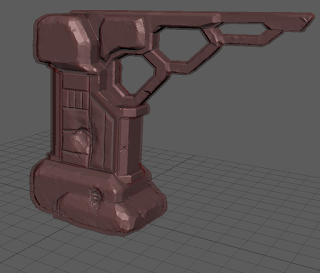My first task in this project is to create a model of a desk lamp in Maya. Before the first lesson we had an introductory lecture to cover the basics and fundamentals of how three dimensional objects are rendered in a game engine and why it is important to consider what a game engine can and can't render well.
This lecture also covered what a 3D model is;
They are all made up of Vertices, Edges and Faces. Vertices being the corners and edges specifically are lines on the model made of two vertices and faces being a set of connected edges that form a shape. All vertices have have numerical values in a 3D space that go in the labelled directions X,Y and Z.
Polygons, in modelling terms, make up the surface of a solid object. The simplest polygons possible are triangles, however they are best avoided when modelling as they do not necessarily deform correctly when animated and are too fine and angular for round or natural objects. This is why Quads(quadrilaterals) are used for more organic assets as the mesh will deform better. N-gons are polygons with more than five edges and can cause a lot of problems with animation. These are easily avoided however as they can be broken down into triangles or triangles and quads.
It is also important to note that polygons only face in one direction and on their own only have two dimensions. You can often see where a model's mesh finishes in First Person Shooters on PC by modifying the game files to display the game at a higher FOV angle than is present in the game. This is because if a game is developed for console then the FOV is locked and therefore the rest of the gun model isn't always needed and is sometimes not even included in the model itself. Raising a first person games' FOV value may also mean your view may clip into the geometry, allowing you to see the space in between.
UV Mapping is the process of unwrapping the 2D elements of a 3D object. U and V represent X and Y in a 2D plane respectively. Having this unfolded frame means it can be filled with a 2D image to add detail to the 3D object. These are called textures which are then applied to the 3D object to create a detailed 3D asset.
How complex and realistic a texture can be is down to the overall style you desire and your own personal input. Typically games with low memory allocation such as mobile games, tend to have painted textures that include light and shadow details. This is not 'realistic' as light and shadow can now be properly rendered in game engines. So in more advanced games textures are very different. Albedo or diffuse maps are essentially the base colour and basic information of the texture. No light or shadow information should be included in these as they will be rendered in the engine. Details like wear, rust, markings and other decals can be added however as these are specific to one object.
More detail can be added in the form of Normal maps. High polygon meshes are difficult to render as they contain so much information. This performance impact can be negated by the use of normal maps with the Albedo maps. What a Normal map does is take the information from a high poly mesh onto a low poly mesh. Instead of using the 3D XYZ axis it uses the RGB channels of the 2D plane to correspond with the 3D axis to simulate the detail present in the high poly mesh but a much lesser cost of memory.
In addition to normal maps there are metallic and roughness maps. Metallic and roughness maps are not actually textures, they are multiple textures compiled together that make a material that will respond to light in different ways.
Believe it or not this my understanding of my most recent lecture in the simplest way I can put it, however there is a great deal more depth to be covered and finesse to be learnt in workshops to come.






































